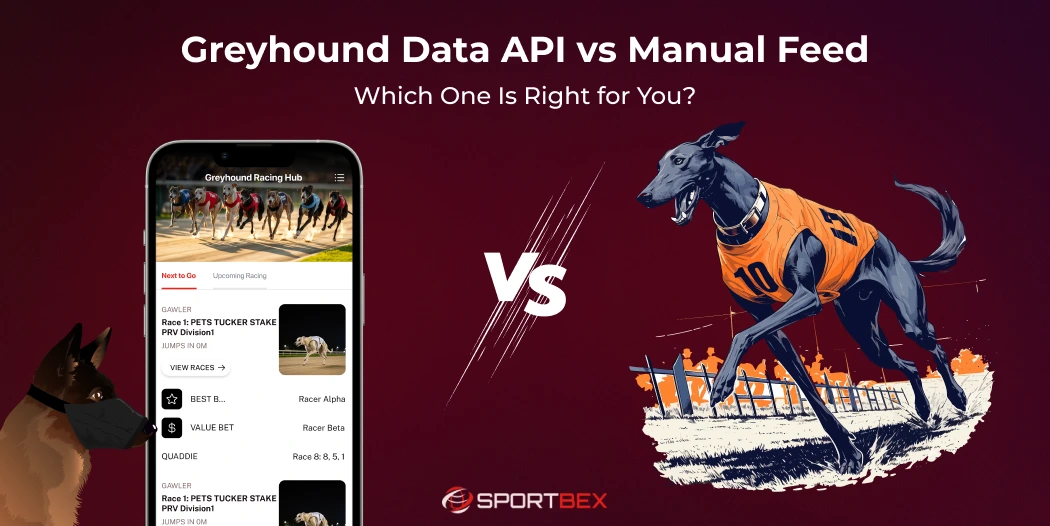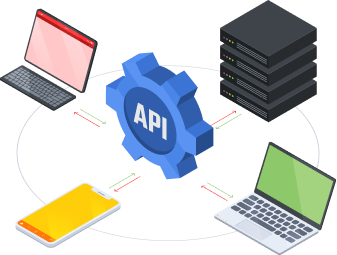The greyhound racing industry has changed a lot with new technology, especially in how data is collected and shared. If you’re building a betting platform, fantasy sports app, or analytics tools, you’ll need to choose between using a Greyhound Data API or manual data feeds. This choice can affect your project’s timeline and user experience.
APIs offer real-time data, making them great for instant updates, while manual feeds give you more control over the data. Both options have their pros and cons, so it’s important to figure out which one fits your needs.
In this guide on Greyhound Data API vs Manual Feed, we’ll break down the key differences between these two methods of delivering greyhound racing data, their benefits and drawbacks, and how to choose the best option for your project. By the end, you’ll know exactly which method works best for your platform’s greyhound racing data needs.
What Is a Greyhound Data API?
A Greyhound Data API is an automated interface designed to provide real-time or scheduled greyhound racing data directly to your applications, websites, or betting platforms. This type of API ensures seamless integration with your systems, allowing you to deliver up-to-date information to your users.
Through RESTful or WebSocket endpoints, users can access a wide range of data, including live race scores, detailed dog statistics, race schedules, track conditions, and historical performance metrics. Whether you’re building a betting platform, a racing app, or a statistics dashboard.
A Greyhound live data API lets developers add live racing updates and results directly into their systems. This means the data stays accurate and updates in real-time. It’s perfect for platforms like sportsbooks, fantasy sports app, or performance trackers that need up-to-the-second information.
If you use any Greyhound API, you can access data directly without needing to manually process or upload files. This makes it easy to share and scale data across different platforms.
What Is a Manual Data Feed?
A manual data feed for betting refers to the traditional method of collecting and sharing greyhound racing data through formats such as files, spreadsheets, or bulk downloads. This approach relies on manually transferring data between systems, which can sometimes be a time-consuming and labor-intensive process.
The feed is typically updated periodically, such as hourly or daily, and often requires human intervention for various tasks, including processing, uploading, or analyzing the data.
Manual feeds aren’t great for real-time use but can work well for analyzing past data, basic betting models, or businesses with simpler technology needs.
Manual feeds might be sent through FTP servers, email attachments, or downloadable links. While this approach offers more control over how data is handled and presented, it also comes with limitations in terms of timeliness, accuracy, and labor intensity.
Key Differences Between Greyhound API and Manual Feed
The key difference between the two methods is when they deliver data. A Greyhound live data API updates instantly, while manual feeds send data in batches at scheduled times.
| Feature | Greyhound Data API | Manual Data Feed |
|---|---|---|
| Speed | Real-time or near real-time | Delayed (hourly/daily updates) |
| Automation | Fully automated | Requires manual processing |
| Integration | Easy integration via code | Requires import/setup |
| Accuracy | High (live updates reduce errors) | Prone to human error |
| Maintenance | Minimal | Ongoing manual work |
| Customization | High | Limited |
| Cost Efficiency | Scalable; cost-effective over time | Higher labor cost |
| Scalability | Highly scalable | Less scalable |
Pros and Cons of Using a Greyhound API
Pros
- Real-Time Access: Stay ahead with instant updates on race results, odds, and greyhound performance metrics, delivered within milliseconds to keep you informed at all times.
- Automated Updates: Save time and effort with fully automated data delivery and refreshing, eliminating the need for any manual intervention or monitoring.
- High Scalability: Designed to grow with your business, this solution handles high volumes of traffic effortlessly, making it ideal for expanding platforms or enterprises looking to scale.
- Customization Options: Tailor your experience by selecting exactly what data you want to retrieve and how frequently, ensuring the information aligns perfectly with your needs.
- Better User Experience: Enhance the usability and appeal of your apps or platforms by integrating seamless real-time updates, keeping users engaged and satisfied with up-to-date information.
Cons
- Requires Technical Setup: Integrating APIs often requires skilled developers to handle the technical setup, such as configuring endpoints, managing authentication, and ensuring the API works seamlessly with your existing systems.
- Ongoing Subscription Fees: Most APIs operate on a subscription-based model, which means you’ll need to account for monthly fees in your budget. Costs can vary depending on usage limits, premium features, or specific data access needs.
- Dependency on Provider Uptime: Your system’s reliability is tied to the uptime of the API provider. If the provider experiences outages or downtime, your access to critical data or functionality can be disrupted, potentially impacting your operations.
If you’re creating a sports betting platform or an app tailored for racing fans, integrating a Greyhound Live Score API can give you a competitive edge. This powerful tool provides real-time race updates, detailed scoring, and accurate data that keeps users engaged and informed.
Pros and Cons of Using Manual Feeds
Pros
- Simplicity: Perfect for businesses that don’t have a dedicated tech team or technical expertise. Easy to set up and manage without needing advanced skills.
- Lower Initial Cost: Eliminates the need for coding or software development, making it a cost-effective solution for small to medium businesses or those just starting out.
- Data Ownership: Offers full control over your information. Feeds can be stored, customized, manipulated, and archived locally, ensuring your data remains accessible and secure at all times.
Cons
- Delayed Updates: This method is not suitable for real-time betting platforms that rely on instant data updates. Any delay in processing or delivery can lead to outdated information, impacting the user experience and accuracy of the platform.
- Manual Labor: The process requires dedicated staff to handle, clean, and manually import the data into the system. This not only increases operational costs but also consumes valuable time that could be used for other critical tasks.
- Higher Risk of Errors: With human involvement in the data handling process, there is a greater likelihood of errors such as misentries, mismatches, or omissions, which can compromise the integrity of the platform.
- Less Efficient: This approach lacks scalability, making it unsuitable for platforms with large operations or those experiencing rapid growth. The more the platform expands, the more manual work is required, which can quickly become unmanageable.
Manual feeds can work for historical analysis or small-scale betting but may fall short in fast-paced, real-time environments.
Which One Should You Choose?
The Decision between the Greyhound Data API vs Manual Feed depends on what you need and how technical your setup is. Here’s a simple guide to help you decide!
Choose a Greyhound API if:
- You need real-time greyhound racing data.
- You’re building a sportsbook, fantasy sports platform, or automated betting system.
- You have a tech team that can handle API integration.
- You value scalability and low-latency performance.
Choose a Manual Feeds if:
- Your platform doesn’t require real-time data.
- You’re focused on historical data analysis.
- Your business is still in early stages or you’re running a small operation.
- You lack technical infrastructure.
How to Get Started with a Greyhound API
Getting started with a Greyhound Data API involves several key steps, but with the right provider and technical team, the process can be streamlined effectively. Here’s a quick roadmap:
- Identify Your Data Needs: Decide what kind of greyhound racing data you need—live scores, race schedules, dog performance stats, or historical data.
- Choose a Reputable Provider: Look for a data vendor that offers a stable, well-documented Greyhound API with clear pricing, support, and uptime guarantees.
- Sign Up and Obtain API Keys: Most providers require account creation and offer unique API keys for authentication.
- Review API Documentation: Study the developer docs to understand endpoints, request methods, data formats (usually JSON), rate limits, and error handling.
- Develop and Test Integration: Work with your development team to integrate the API into your application or platform. Use sandbox environments if available.
- Monitor and Optimize: Once live, monitor API performance and usage. Optimize data calls to avoid hitting rate limits or causing unnecessary load.
By following these steps, you’ll be able to leverage greyhound racing data in a way that’s fast, scalable, and tailored to your platform’s specific needs.
Conclusion
In greyhound racing and sports betting, having accurate and up-to-date information is essential. As you weigh the options between a Greyhound Data API vs Manual Feed, consider what your platform and audience demand. APIs offer speed, automation, and scalability, making them ideal for modern applications. Manual feeds, while simpler, come with limitations that may hamper long-term growth.
Using a Greyhound live data API makes your platform ready for the future and keeps it competitive. It works even better when combined with tools like the greyhounds odds API or other Greyhound Racing APIs.
If you want to improve user experience, save time, and grow your platform smoothly, a data API is the best choice. For beginners or those only needing basic analytics, manual data feeds can work too—just remember they have some limits.
Frequently Asked Questions
APIs from established sports data providers are typically the most reliable due to real-time syncing and automatic updates.
Yes. Many platforms use manual feeds for historical data and APIs for real-time updates.
It depends on your development team. Most modern APIs are well-documented, making integration straightforward for experienced developers.
Yes. Look for a Greyhound Live Score API that specializes in real-time race data.
Consider integrating a Fantasy Sports API, a Sports Data API, and a greyhounds odds API to expand functionality and appeal to a broader audience.
Recent Blog
Live Casino API Providers in India
July 25, 2025
 9 min
9 minHow to Build a Live Cricket Score Widget with Cricket API
July 24, 2025
 9 min
9 min








